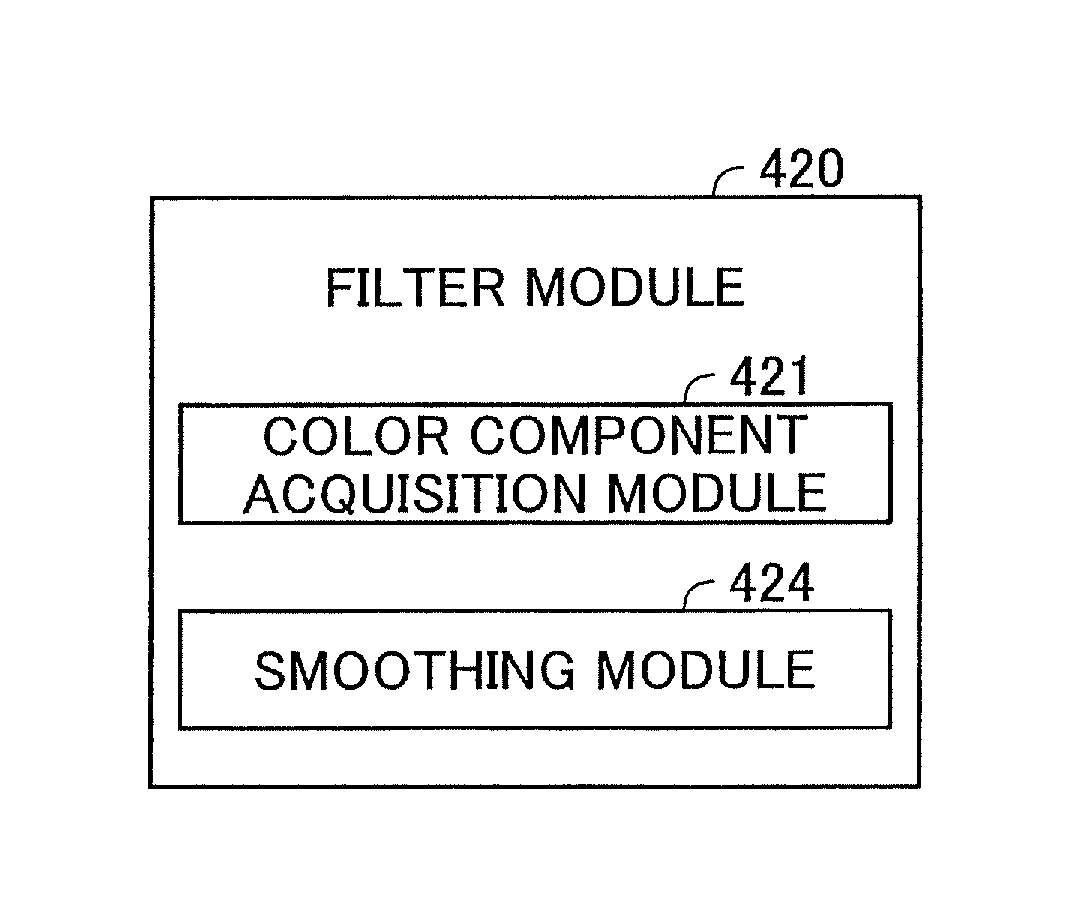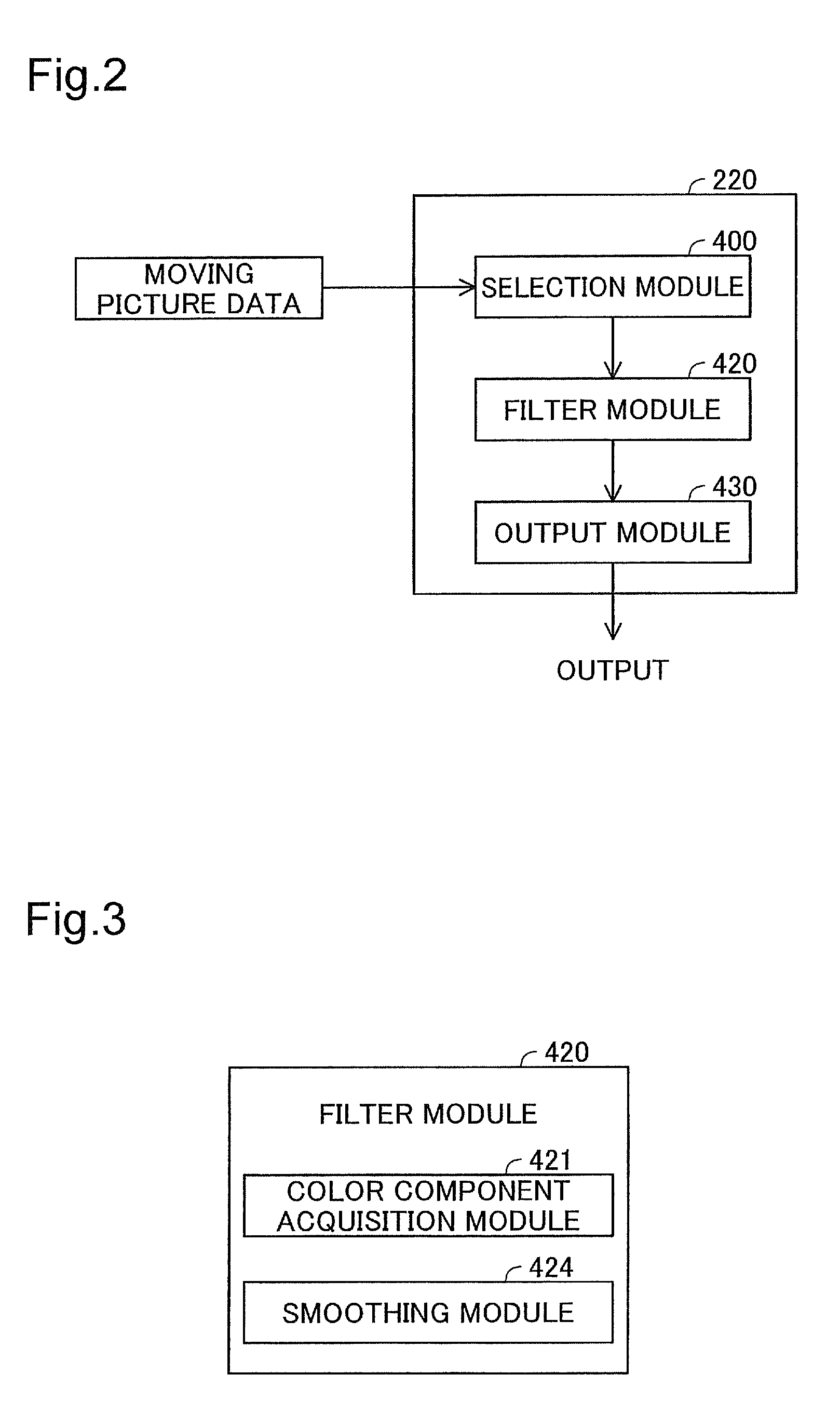Apparatus, method, and program product for image processing
a program product and image processing technology, applied in image enhancement, color signal processing circuits, instruments, etc., can solve problems such as data encoding (e.g. compression) noise, and achieve the effects of reducing noise, suppressing excessive blurring of images, and reducing nois
- Summary
- Abstract
- Description
- Claims
- Application Information
AI Technical Summary
Benefits of technology
Problems solved by technology
Method used
Image
Examples
embodiment 1
B1. Embodiment 1 of Smoothing Process Utilizing Block Noise Strength;
[0073]FIG. 5 is a schematic diagram of a picture. In this embodiment, a single picture PCT represents a rectangle image. Additionally, the single picture PCT have been split into a plurality of pixel blocks BLK of rectangle shape, with the data encoded on an individual pixel block BLK basis. These pixel blocks BLK are arrayed in lines respectively in the horizontal direction hr and in the vertical direction vt. In the embodiment, each pixel block BLK is a block of 8*8 pixels. The selection module 400 restores the frame image data by decoding the data of each individual pixel block BLK.
[0074]Various values may be employed for the pixel count in the horizontal direction hr and the pixel count in the vertical direction vt of the picture PCT. For a given image (subject) represented by the picture PCT, a larger pixel count of the picture PCT means that each single pixel block BLK represents a more detailed portion of th...
embodiment 2
B2. Embodiment 2 of Smoothing Process Utilizing Block Noise Strength:
[0122]FIG. 20 is an illustration depicting an overview of another embodiment of the smoothing process. The only difference from the embodiment depicted in FIG. 17 is that the magnitude of smoothing becomes stronger as the pixel position within a pixel block become closer to the boundary line. The device configuration and process steps are the same as in the embodiment illustrated in FIGS. 1A-1B, FIG. 2, FIG. 9, and FIG. 10.
[0123]The drawing depicts an example of a smoothing level matrix SL. This 8*8 matrix SL indicates a smoothing level at each pixel position within a pixel block. In the example of FIG. 20, the level is set to any of levels 1 to 4. Higher levels mean stronger smoothing. Also, the level is set to a greater value with decreasing distance from the boundary line Bn, Be, Bs, Bw of the pixel block.
[0124]The drawing depicts the target image SI and the pixel block group BG similar to those in FIG. 11. The ...
embodiment 3
B3. Embodiment 3 of Smoothing Process Utilizing Block Noise Strength:
[0129]FIG. 21 is an illustration depicting an overview of yet another embodiment of the smoothing process. The only difference from the embodiment depicted in FIG. 17 is that the normalized strength calculated through interpolation depending on pixel position within the pixel block is used in place of the representative normalized strength αf. The device configuration and process steps are the same as in the embodiment illustrated in FIGS. 1A-1B, FIG. 2, FIG. 9, and FIG. 10.
[0130]FIG. 21 depicts an overview of the smoothing process of a given target pixel PXx. In this embodiment, the smoothing module 424 (FIG. 9) calculates a horizontal normalized strength αph1 through linear interpolation of the horizontal direction hr, and a vertical normalized strength αpv1 through linear interpolation of the vertical direction vt.
[0131]The horizontal normalized strength αph1 is calculated from the left normalized strength αw of...
PUM
 Login to View More
Login to View More Abstract
Description
Claims
Application Information
 Login to View More
Login to View More - R&D
- Intellectual Property
- Life Sciences
- Materials
- Tech Scout
- Unparalleled Data Quality
- Higher Quality Content
- 60% Fewer Hallucinations
Browse by: Latest US Patents, China's latest patents, Technical Efficacy Thesaurus, Application Domain, Technology Topic, Popular Technical Reports.
© 2025 PatSnap. All rights reserved.Legal|Privacy policy|Modern Slavery Act Transparency Statement|Sitemap|About US| Contact US: help@patsnap.com



